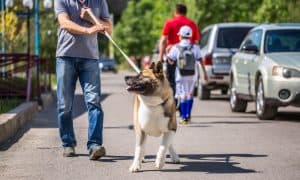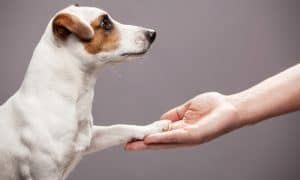“This post contains affiliate links, and I will be compensated if you make a purchase after clicking on my links.”

Some dogs have a severe fear of strangers. Dogs often exhibit fearfulness when near strangers. When they see someone new, they quake, shrink, and make an attempt to hide.
Some people presume right away that these dogs have suffered past abuse. This is not typically the case. Most of the time, a dog’s fear of strangers is caused by poor socialization. It is crucial to expose young puppies to as many strangers and environments as you can during the crucial socialization phase between 3 and 16 weeks of age and make sure that every new experience is positive. When a dog reaches the age of 16 weeks and hasn’t been exposed to a wide range of people, it may begin to exhibit signs of fearfulness toward strangers as it matures.
Although it’s fairly uncommon for dogs to be wary of strangers, the best response is open friendliness rather than hiding or fleeing. It’s a good idea to know why your dog is so scared of strangers if you want to help it overcome its fear.
Many people assume that all dogs will interact with people in a natural manner. However, it’s not always the case. Even dogs who genuinely enjoy interacting with people occasionally experience tension, anxiety, or discomfort when meeting new people. Your dog should practice meeting and quietly being petted by a variety of people in order to learn how to positively and appropriately interact with a stranger. But it can be a little trickier for dogs who are wary of new people.
Have every new guest absolutely ignore the dog whenever they arrive. The dog should not be approached by a pet or make eye contact with the guest. When a visitor comes over, have some treats ready for them to gently throw on the floor next to your dog. Your anxious dog might eventually start to associate rewards with strangers with consistent training.
Another tip is to give your dog personal space. It helps if the dog has a place where it knows it will be left alone, such as a quiet room. Your dog might easily retreat to a crate when it becomes very frightened. It might also be beneficial to spray calming dog pheromones or apply a thundershirt where it feels comfortable. The dog has to have a place where it can be left alone and unbothered, so if your pet is in a safe place, do not let anyone go in there and pull it out or even try to pet it.
It’s important to talk to your vet about your pet’s fear because they can advise you on at-home strategies and talk about whether medication might be necessary. The consultation of a board-certified veterinary behaviorist who focuses on dogs with behavioral issues like fear may even be advised by veterinarians. Or, they might suggest hiring a professional dog trainer for at-home training.























